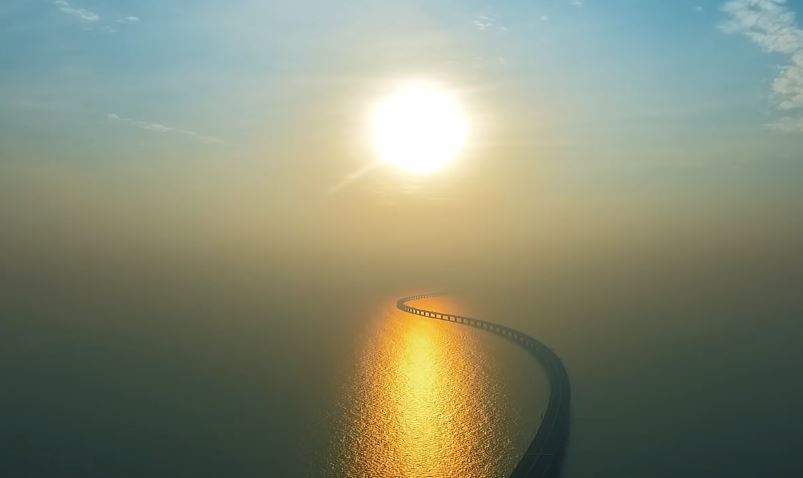
The Hong Kong-Zhuhai-Macau Bridge has yet to open to the public. However, there are already concerns about the safety of the 55 kilometre sea-crossing structure.
Pro-democracy activists have managed to capture aerial shots of an artificial island which appears to show damaged to wave-absorbing concrete blocks.
#HongKong Highways Department: there’s no safety issues with the breakwater structure on the artificial island for the bridge to #Macau & #Zhuhai, after inspecting the site themslves and having a meeting with mainland officials overseeing the structure. “Nothing was washed away” pic.twitter.com/JLlC9VONJq
— Damon Pang (@damon_pang) April 9, 2018
The authority placed these blocks, known as dolosse, to stop the sea from eroding the island. However, they appear to have dislodged and drifted away.
How well do you really know your competitors?
Access the most comprehensive Company Profiles on the market, powered by GlobalData. Save hours of research. Gain competitive edge.

Thank you!
Your download email will arrive shortly
Not ready to buy yet? Download a free sample
We are confident about the unique quality of our Company Profiles. However, we want you to make the most beneficial decision for your business, so we offer a free sample that you can download by submitting the below form
By GlobalDataRegardless, Chinese officials from the Hong Kong-Zhuhai-Macau Bridge Authority have insisted that the image doesn’t show damage and that the structure was deliberately designed as it appears.
According to the authority, these blocks need to be randomly positioned due to the undersea tunnel that passes under the island. A high concentration of blocks would put too much pressure on the structure.
However, experts refute these claims. Civil engineer Simon So Yiu-kwan told the South China Morning Post that the pattern of the blocks seemed to suggest that they had collapsed and drifted away.
Read more: Hong Kong-Zhuhai-Macau Bridge: Despite delays and rising costs, locals remain positive
So Yiu-kwan told SCMP:
“The blocks are already under water. How will they absorb waves?”
According to So Yiu-kwan, each block weighs only five tonnes, making them too light for use in the sea. He suggests that blocks weighing 25 tonnes would be more secure.
The images have prompted calls for Hong Kong to take more control of the development of HZMB. The director, chief engineer and many other members of staff at the bridge authority are from mainland China.
Hong Kong has contributed 10.7 billion HKD to the development of the bridge, approximately 43% of all costs involved.
What was said:
Member of the Legislative Council of Hong Kong Yiu Chung-yim, told SCMP:
“The Hong kong government needs to fight for more say.”
“If safety problems do happen to the island in future, it may affect the bridge section in Hong Kong waters. At that time, who’s going to pay for fixing and compensation?”
Why it matters:
The Hong Kong Government estimates that 29,000 people will be crossing the bridge each day by 2030, rising to 42,000 people by 2037. Any structural issues with the bridge could potentially put thousands of lives at risk.
The issue, if it is one, will surely be resolved before the bridge opens to the public.
However, this will prompt yet more backlash about the cost of the project, which those in Hong Kong have already voiced concerns about.
Bob McKercher, professor of tourism management at the Hong Kong Polytechnic University told Verdict:
“This bridge is an example of good old-fashioned 19th-century nation building by the central government. It is extremely costly and from the recent estimates I have seen, it will never cover its costs. It seems to be a piece of infrastructure development for no other reason than infrastructure development.”
However, the Hong Kong Highways Department insists that the bridge will benefit Hong Kong, telling Verdict:
“Hong Kong will benefit from this new economic hinterland, with its vast human and land resources which will provide ample opportunities for Hong Kong businessmen to expand their operation in the Mainland.”
Background:
Once completed, the Hong Kong-Zhuhai-Macau Bridge will become the world’s largest sea-crossing bridge, measuring 55km.
Constructing the bridge has taken eight years, 420,000 tonnes of steel and 1.1 million cubic meters of cement.
The bridge authority claims that the bridge will be able to withstand magnitude eight earthquakes and super typhoons.
HZMB will reduce travel time between Hong Kong and Zhuhai from three hours down to thirty minutes.







